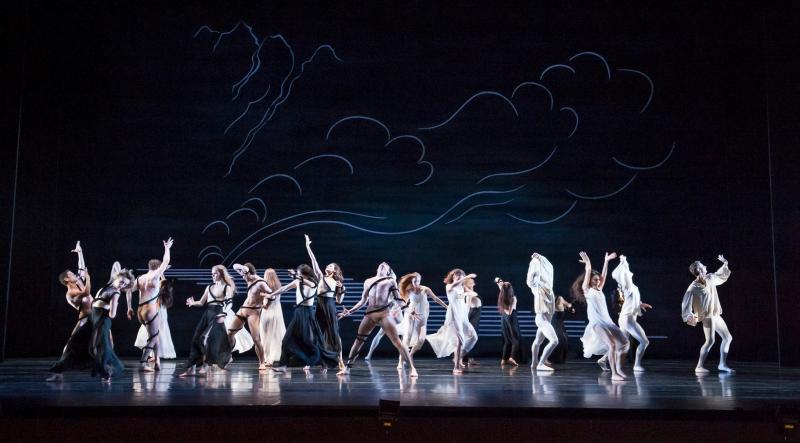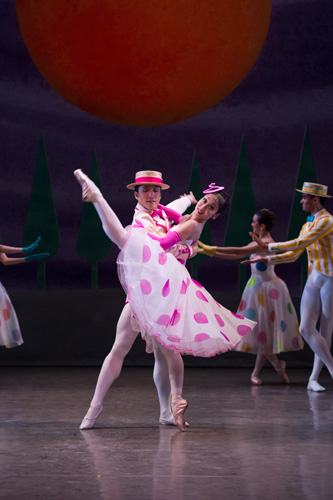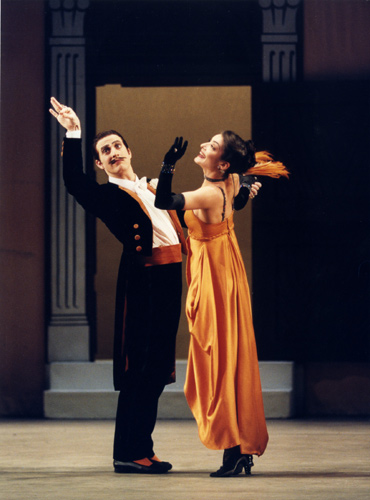Les Rendezvous/Dante Sonata/Façade, Birmingham Royal Ballet, Birmingham Hippodrome | reviews, news & interviews
Les Rendezvous/Dante Sonata/Façade, Birmingham Royal Ballet, Birmingham Hippodrome
Les Rendezvous/Dante Sonata/Façade, Birmingham Royal Ballet, Birmingham Hippodrome
Three early works by Sir Frederick Ashton have plenty of charm, but is a 'light touch' ever too light?

“The touch is light. We like it so,” wrote Ninette de Valois in one of her later poems. You didn’t know the founder of the Royal Ballet wrote poetry? Don’t worry, you’re not missing much – except the occasional phrase which can serve as an epigraph for early English ballet.
Birmingham Royal Ballet – which shares with the choreographer the quality of wearing its excellence lightly – is having a mini Ashton season just now, with this triple bill of early short ballets – the elegiac Dante Sonata bracketed by 1930s romps Les Rendezvous and Façade – followed next week by La Fille mal gardée.
 Les Rendezvous (1933) is the perfect example of the choreographer’s vaunted light touch – it might appear frothy to the point of insubstantiality, especially with Anthony Ward’s preschool-bright polka dot dresses, but it’s actually a solid little gem of classical choreography, and pretty bloody difficult to boot. Elegant Nao Sakuma (pictured right) gives an impressively neat, sweet account of the virtuoso part created for Alicia Markova, but she doesn’t have the sparkle and sass to make it really sing – while, conversely, Arancha Baselga has sparkle and sass, but couldn’t keep it neat in the pas de trois. Miki Mizutani stood out in the all-girl pas de quatre – a specialist genre of choreography, by the way, at which, to my mind, Ashton blows everyone else out of the water (yes, even those cygnets). And all the women of the corps deserve a very warm mention for staying so beautifully together and for their perfectly schooled, perfectly charming arms and faces.
Les Rendezvous (1933) is the perfect example of the choreographer’s vaunted light touch – it might appear frothy to the point of insubstantiality, especially with Anthony Ward’s preschool-bright polka dot dresses, but it’s actually a solid little gem of classical choreography, and pretty bloody difficult to boot. Elegant Nao Sakuma (pictured right) gives an impressively neat, sweet account of the virtuoso part created for Alicia Markova, but she doesn’t have the sparkle and sass to make it really sing – while, conversely, Arancha Baselga has sparkle and sass, but couldn’t keep it neat in the pas de trois. Miki Mizutani stood out in the all-girl pas de quatre – a specialist genre of choreography, by the way, at which, to my mind, Ashton blows everyone else out of the water (yes, even those cygnets). And all the women of the corps deserve a very warm mention for staying so beautifully together and for their perfectly schooled, perfectly charming arms and faces.
Dante Sonata was legendary in the decade after its creation for capturing, seriously, honestly, and without jingoism, the fear, uncertainty and impotence people felt during the Second World War. Although the ballet’s intrinsic qualities – Constant Lambert’s orchestration of Liszt, Sophie Fedorovich’s designs, and dancing from Robert Helpmann, Pamela May and Margot Fonteyn – attracted a great deal of praise, the wartime context clearly influenced its ecstatic reception. When the critic PW Manchester wrote in 1942, “Dante Sonata is so much more than a ballet that, as [Arnold] Haskell has said, one never thinks of the choreography,” her praise highlights a potential problem for modern audiences. When few people in the theatre have lived through that war or any comparable experience, can we still "get" Dante Sonata?
The dark, modernist set, the sweeping Liszt score, the soft white dresses and sweeping black skirts, the loose-haired, barefoot dancers, still present an experience of remarkable aesthetic unity, and there is huge power in the final moments, as the two warring groups (generally dubbed Children of Light and Children of Darkness) come together, and we realise that (Manchester again) “there is no final victory or final defeat for either, nor any happiness to be found merely in the fact of being either Good or Evil.”
But the expressionistic struggles which go before now seem laboured and over-mannered, and Elisha Willis’s recreation of May’s famous tormented solo reads as tiresomely histrionic. The Children of Darkness are well served by having the lean, dark-eyed Samara Downs and the imposing, muscular Tyrone Singleton as their leaders, both powerful stage presences, but even their charisma can't turn this museum piece into the searing experience it used to be.
 Façade (1931) is another piece I suspect ain't what it used to be. A contemporary audience will laugh at the intrinsic humour of dancers being silly, but will they recognise the more delicious comedy of Façade's accurate parodies – of airhead débutantes waltzing, the aging smart set doing the foxtrot, and a brilliantined roué Spanish character named, with retro political incorrectness, The Dago? There were titters aplenty from the (mostly silver-haired) matinée audience in the Hippodrome, particularly for Kit Holder and Lewis Turner’s stony-faced Popular Song, and Valentin Olovyannikov's devilish, eyebrow-waggling Dago (pictured left), but no belly laughs, and in all it feels like rather a cheap account of Ashton’s tremendous talent. However great the choreographer, however much soul the dancers put in, sometimes the touch can be just too light.
Façade (1931) is another piece I suspect ain't what it used to be. A contemporary audience will laugh at the intrinsic humour of dancers being silly, but will they recognise the more delicious comedy of Façade's accurate parodies – of airhead débutantes waltzing, the aging smart set doing the foxtrot, and a brilliantined roué Spanish character named, with retro political incorrectness, The Dago? There were titters aplenty from the (mostly silver-haired) matinée audience in the Hippodrome, particularly for Kit Holder and Lewis Turner’s stony-faced Popular Song, and Valentin Olovyannikov's devilish, eyebrow-waggling Dago (pictured left), but no belly laughs, and in all it feels like rather a cheap account of Ashton’s tremendous talent. However great the choreographer, however much soul the dancers put in, sometimes the touch can be just too light.
- Birmingham Royal Ballet are performing La Fille mal gardée at the Birmingham Hippodrome 11-15 June and the Theare Royal Nottingham 25-28 June
Follow Hanna @hweibye on Twitter
rating
Explore topics
Share this article
The future of Arts Journalism
You can stop theartsdesk.com closing!
We urgently need financing to survive. Our fundraising drive has thus far raised £49,000 but we need to reach £100,000 or we will be forced to close. Please contribute here: https://gofund.me/c3f6033d
And if you can forward this information to anyone who might assist, we’d be grateful.

Subscribe to theartsdesk.com
Thank you for continuing to read our work on theartsdesk.com. For unlimited access to every article in its entirety, including our archive of more than 15,000 pieces, we're asking for £5 per month or £40 per year. We feel it's a very good deal, and hope you do too.
To take a subscription now simply click here.
And if you're looking for that extra gift for a friend or family member, why not treat them to a theartsdesk.com gift subscription?
more Dance
 'We are bowled over!' Thank you for your messages of love and support
Much-appreciated words of commendation from readers and the cultural community
'We are bowled over!' Thank you for your messages of love and support
Much-appreciated words of commendation from readers and the cultural community
 R:Evolution, English National Ballet, Sadler's Wells review - a vibrant survey of ballet in four acts
ENB set the bar high with this mixed bill, but they meet its challenges thrillingly
R:Evolution, English National Ballet, Sadler's Wells review - a vibrant survey of ballet in four acts
ENB set the bar high with this mixed bill, but they meet its challenges thrillingly
 Like Water for Chocolate, Royal Ballet review - splendid dancing and sets, but there's too much plot
Christopher Wheeldon's version looks great but is too muddling to connect with fully
Like Water for Chocolate, Royal Ballet review - splendid dancing and sets, but there's too much plot
Christopher Wheeldon's version looks great but is too muddling to connect with fully
 iD-Reloaded, Cirque Éloize, Marlowe Theatre, Canterbury review - attitude, energy and invention
A riotous blend of urban dance music, hip hop and contemporary circus
iD-Reloaded, Cirque Éloize, Marlowe Theatre, Canterbury review - attitude, energy and invention
A riotous blend of urban dance music, hip hop and contemporary circus
 How to be a Dancer in 72,000 Easy Lessons, Teaċ Daṁsa review - a riveting account of a life in dance
Michael Keegan-Dolan's unique hybrid of physical theatre and comic monologue
How to be a Dancer in 72,000 Easy Lessons, Teaċ Daṁsa review - a riveting account of a life in dance
Michael Keegan-Dolan's unique hybrid of physical theatre and comic monologue
 A Single Man, Linbury Theatre review - an anatomy of melancholy, with breaks in the clouds
Ed Watson and Jonathan Goddard are extraordinary in Jonathan Watkins' dance theatre adaptation of Isherwood's novel
A Single Man, Linbury Theatre review - an anatomy of melancholy, with breaks in the clouds
Ed Watson and Jonathan Goddard are extraordinary in Jonathan Watkins' dance theatre adaptation of Isherwood's novel
 Peaky Blinders: The Redemption of Thomas Shelby, Rambert, Sadler's Wells review - exciting dancing, if you can see it
Six TV series reduced to 100 minutes' dance time doesn't quite compute
Peaky Blinders: The Redemption of Thomas Shelby, Rambert, Sadler's Wells review - exciting dancing, if you can see it
Six TV series reduced to 100 minutes' dance time doesn't quite compute
 Giselle, National Ballet of Japan review - return of a classic, refreshed and impeccably danced
First visit by Miyako Yoshida's company leaves you wanting more
Giselle, National Ballet of Japan review - return of a classic, refreshed and impeccably danced
First visit by Miyako Yoshida's company leaves you wanting more
 Quadrophenia, Sadler's Wells review - missed opportunity to give new stage life to a Who classic
The brilliant cast need a tighter score and a stronger narrative
Quadrophenia, Sadler's Wells review - missed opportunity to give new stage life to a Who classic
The brilliant cast need a tighter score and a stronger narrative
 The Midnight Bell, Sadler's Wells review - a first reprise for one of Matthew Bourne's most compelling shows to date
The after-hours lives of the sad and lonely are drawn with compassion, originality and skill
The Midnight Bell, Sadler's Wells review - a first reprise for one of Matthew Bourne's most compelling shows to date
The after-hours lives of the sad and lonely are drawn with compassion, originality and skill
 Ballet to Broadway: Wheeldon Works, Royal Ballet review - the impressive range and reach of Christopher Wheeldon's craft
The title says it: as dancemaker, as creative magnet, the man clearly works his socks off
Ballet to Broadway: Wheeldon Works, Royal Ballet review - the impressive range and reach of Christopher Wheeldon's craft
The title says it: as dancemaker, as creative magnet, the man clearly works his socks off
 The Forsythe Programme, English National Ballet review - brains, beauty and bravura
Once again the veteran choreographer and maverick William Forsythe raises ENB's game
The Forsythe Programme, English National Ballet review - brains, beauty and bravura
Once again the veteran choreographer and maverick William Forsythe raises ENB's game

Add comment